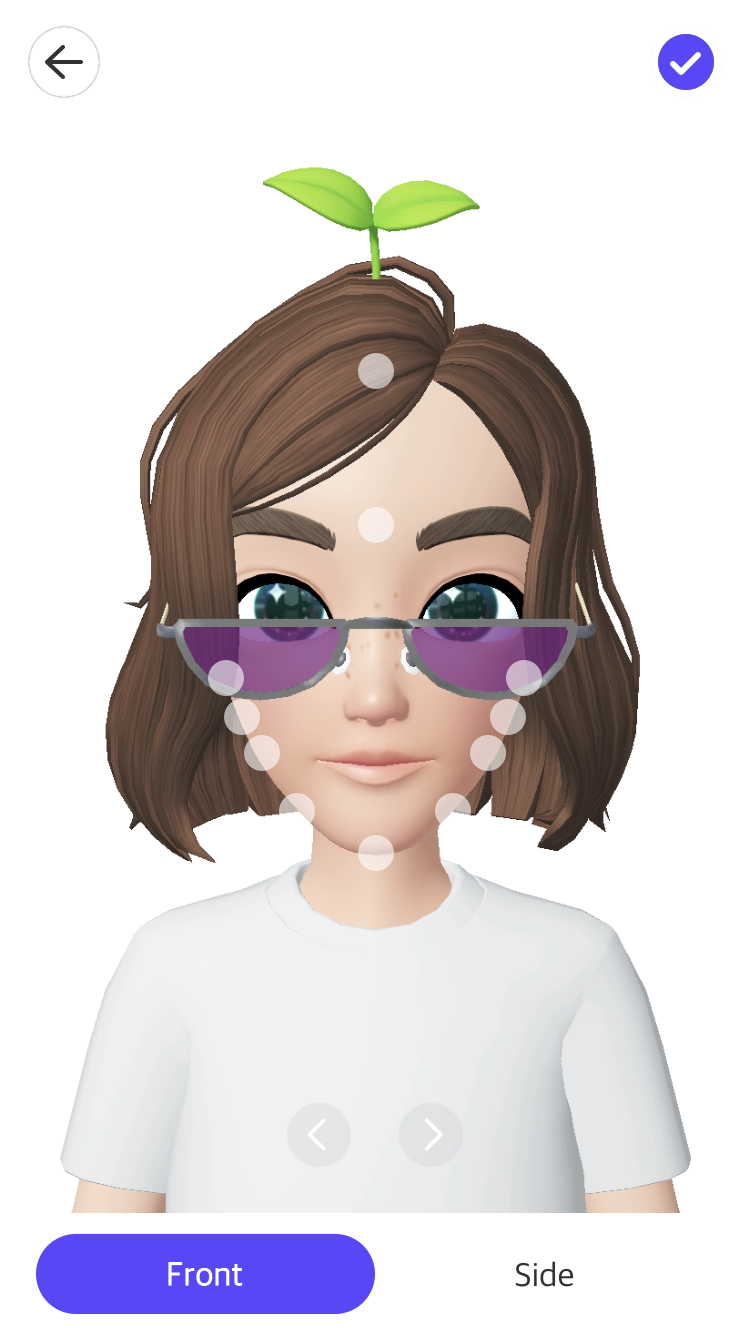ZEPETO
The first platform I chose to make an avatar with is called ZEPETO, a South Korean app that allows users to make an avatar, build a room and take pictures with friends.
One interesting feature is that it “autocreates” your avatar using the front camera. I started with this and then edited it heavily from there. I was surprised the extent to which I had control over almost every part of the face. The app lets you reposition and resize the overall face shape, nose, eyes, lips and eyebrows (which is a bit hard to do on a small screen). You can choose these parts to a certain extent - for some that are fancier/more desirable/more detailed features you have to pay using coins. I decided to buy a leaf for my hair and some cool purple glasses. You cannot change the age of the avatar, so everyone looks like a cartoon version of a teenager. You also cannot choose your body type or customize different parts of your body, but you can select or “buy” different clothes which have different body shapes associated with them.
This is an accurate representation of me to the extent that this avatar also has brown wavy hair and freckles and the same skin color. It’s a little off-putting that it looks so young - in retrospect I wonder if I should have re-made myself as a teenager. Even though I could edit the facial features I don’t think they look like mine. It’s hard not to like it because it’s so cute (and I’m kind of obsessed with the background options), but don’t feel much connection to it.
Oculus
At first I tried Adobe Fuse but became so disturbed and daunted by it I switched to Oculus. I was curious about the Oculus avatars ever since I saw the launch video for Facebook Horizon - in particular I wondered what it would be like to have an avatar without legs.
In Oculus the user can pick a face, hair, eyewear, eye color, and eyebrow color. For everything the color can be adjusted, but the shape and positioning cannot. After ZEPETO this felt like a very limited set of options. At first I thought that I had somehow selected a male category for the avatar, since most of the faces looked so masculine to me. The face options also showed a range of ages and I almost made an older version of myself.
Since you cannot manipulate the facial features, It seems that that most of the personality comes through in the clothing - there were by far the most number of options in this category.
Even though I gave this avatar pink hair and purple lipstick and crazy glasses, I felt that this one was a better representation of me than the ZEPETO avatar. What bothered me about this avatar was that you cannot add breasts. Since the whole avatar is just a head and a chest, this was very noticeable and actually quite disturbing to “look” in a mirror and not seeing this part of my body.
Oculus versus ZEPETO
Both of these are for social platforms - in ZEPETO’s case, the whole purpose of the app is to create avatars, so it makes sense that there are a lot of customization options. For Oculus, the platform isn’t built specifically around use of the avatars, which is likely why is it more limited.
The best part of ZEPETO was the photobooth section. Shuju and I made our avatars together and then had a lot of fun “taking photos” together - which is done by selecting a photo theme and then adding a friend on the app to be a member of the photo. It actually felt similar to taking photos with friends and not knowing exactly how they are going to turn out and then laughing about it when you see the result.
I also love that if you select a group photo but you don’t have enough people to fill it, it just duplicates your avatar(s):
In terms of interactivity, ZEPETO has built in animations and uses facial tracking to change facial expressions in the AR camera. Oculus is using the headset tracking and I think is listening for sound in order to animate the mouth (when I moved my mouth without speaking nothing happened). This was a little surprising to me, but makes sense for multi-user interactions in VR.
One other huge difference was the platform I built the avatar on. For the Oculus avatar, I made it while in VR which made the experience quite different than making an avatar on my computer or phone. With creating 3D assets I’m used to be able to turn the asset around in space as I’m making it, but this was much more like getting dressed in front of a mirror since I couldn’t look at the back of my head or really see my avatar from the side. I also kept going through the mirror in VR when I tried to get close to my reflection. This did a pretty good job of evoking the feeling that this is what I looked like rather than creating something to represent me.



















